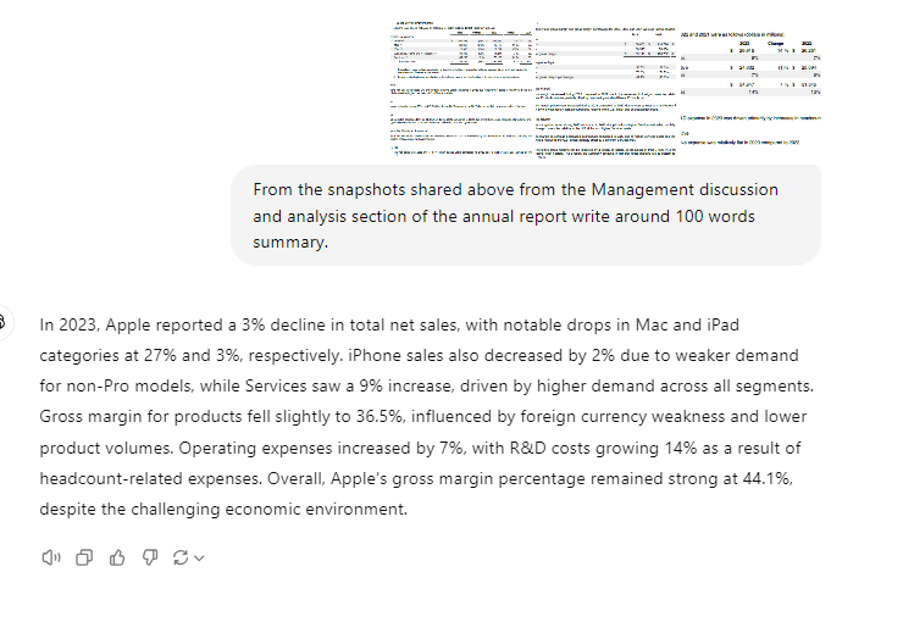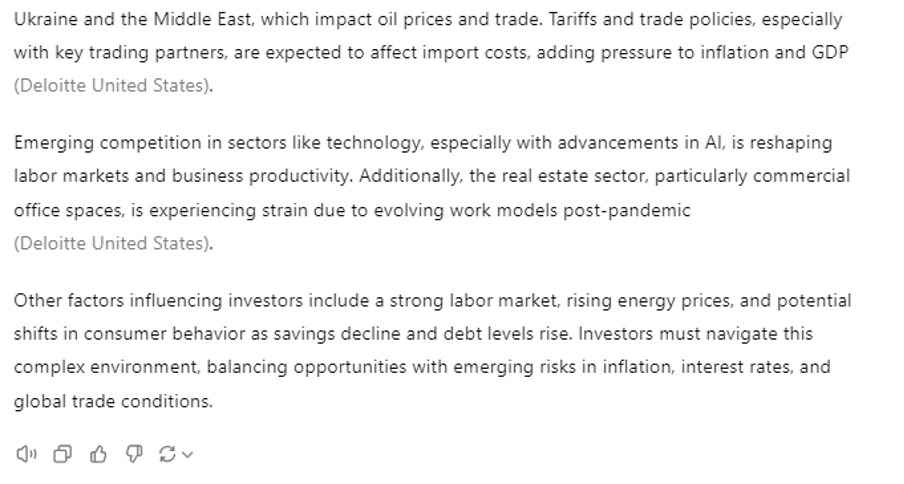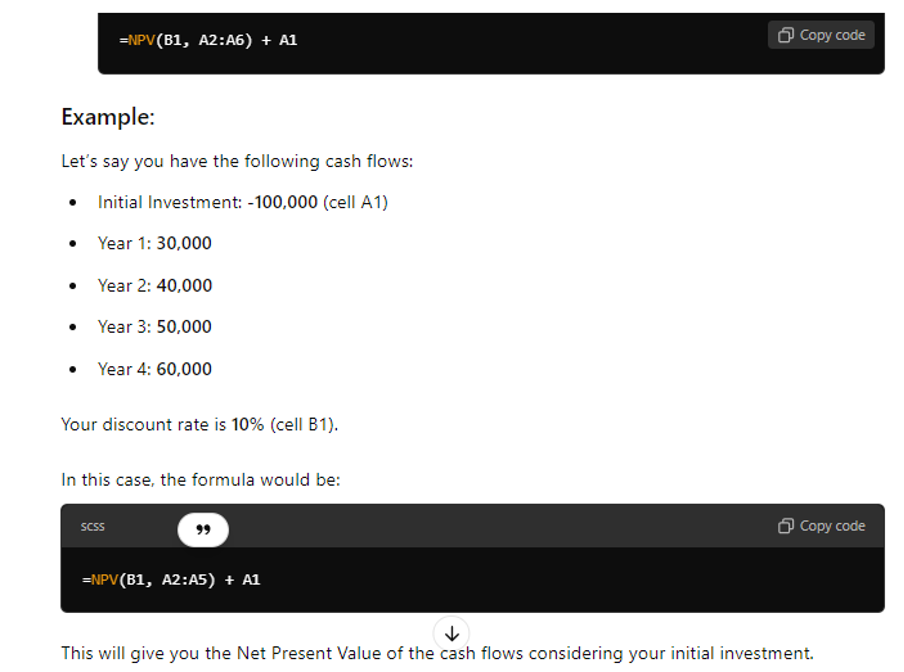INTRODUCTION
In today’s rapidly changing financial landscape, businesses are turning to cutting-edge AI tools to gain a competitive edge in decision-making and analysis. Among these tools, ChatGPT has emerged as the most widely adopted, offering unique insights that help simplify complex financial concepts and streamline data interpretation. While other AI models like Google’s Gemini and Anthropic’s Claude are making waves, financial analysis with ChatGPT, developed by OpenAI, is particularly transformative. This post uncovers ten ways to leverage ChatGPT to boost your financial operations and provides practical steps for integrating it into your business strategy.
CHATGPT IN FINANCE: A VALUABLE ALLY, BUT USE WISELY
Since the introduction of GPT-4o, financial analysis has seen significant improvements. The model’s enhanced natural language processing allows for deeper analysis of financial data, more accurate risk assessments, and the ability to generate actionable insights. This has led to faster, more efficient decision-making and the automation of tasks like compliance monitoring and predictive market analysis.
While ChatGPT can significantly improve financial workflows, it’s crucial to consider its use carefully. If you’ve ever sought financial advice from ChatGPT, you’ve likely noticed that its responses are cautious and often non-committal. This is intentional. AI language models like ChatGPT offer valuable assistance in analyzing data and improving efficiency, but they are not a substitute for the expertise and judgment of professional financial advisors.
These models rely on the data they’ve been trained on, and may not capture every detail of a complex financial situation. For this reason, any insights or recommendations ChatGPT provides should always be verified by experienced financial professionals. Additionally, ensuring compliance with relevant data privacy and security regulations is essential when using AI in financial processes. Considering these factors, let’s explore how ChatGPT can still be an asset in your financial strategy.
TIPS FOR EFFECTIVE PROMPTS IN FINANCIAL ANALYSIS WITH CHATGPT:
- Be Specific: Clearly state the financial concept or data you need to be analyzed.
- Provide Context: Include details like company names, financial metrics, or time frames.
- Ask for Step-by-Step Explanations: If complex, break down the request into smaller parts.
- Use Examples: Reference real-world companies or data to clarify your question.
- Request Comparative Analysis: Ask for comparisons between companies, concepts, or periods to gain better insights.
HOW CHATGPT CAN ASSIST IN FINANCIAL ANALYSIS?
Let’s see how ChatGPT can be used in Financial Analysis.
Illustration 1: Explaining Financial Concepts:
ChatGPT can simplify and explain financial jargon or concepts that may be confusing. It helps individuals grasp fundamental financial terms and metrics by breaking them down into easier-to-understand language.
Example: Suppose we read somewhere that the ROE of Tesla is 20%. ChatGPT explains the term ROE in very simple language and explains it in layman’s terms as follows.

ChatGPT above has explained very well what ROE means in very simple language. Suppose we want to know the exact formula for the same, we can prompt the following question as below.

We can get into much more detail on any financial concept as we can see above by refining our prompts based on the responses we receive. If an answer isn’t quite right, adjust your question to focus on specific aspects or ask it differently.
**
Illustation 2 :Interpreting Financial Statements:
Financial statements provide a snapshot of a company’s financial health, including its income, assets, liabilities, and cash flow. ChatGPT can help interpret these statements to understand what they reveal about a company’s performance.
Example: Suppose we have the Income Statement figures for Apple as follows and we want ChatGPT to interpret the financial performance of Apple in the year 2023 as compared to 2022
| Particulars | 2023 | 2022 | 2021 |
| Net Sales | 3,83,285 | 3,94,328 | 3,65,817 |
| Cost of Sales | 2,14,137 | 2,23,546 | 2,12,981 |
| Gross Margin | 1,69,148 | 1,70,782 | 1,52,836 |
| Operating Expenses | 54,847 | 51,345 | 43,887 |
| Operating Income | 1,14,301 | 1,19,437 | 1,08,949 |
| Other Income(expenses),net | -565 | -334 | 258 |
| Income before Provision for Income Taxes | 1,13,736 | 1,19,103 | 1,09,207 |
| Provision for Income Taxes | 16,741 | 19,300 | 14,527 |
| Net Income | 96,995 | 99,803 | 94,680 |
We can write the following prompt to get the Interpretation.



However, this is a generalized interpretation of the financial data by ChatGPT which could at best be a starting point. To know the exact reason or details for the change in profitability of the company one may have to refer to the annual reports of the company.
**
Illustration 3: Analysing Key Ratios:
ChatGPT can be a powerful tool for analyzing key financial ratios by providing explanations, performing calculations, and offering insights based on the data you provide.
Example: From the given data of Apple Inc. we want to calculate the Current ratio and Quick ratio and analyze the ratios.
| Particulars | Amount |
| Current Assets | 1,43,566 |
| Inventories | 6,331 |
| Current Liabilities | 1,45,308 |



As we can see above ChatGPT calculates the ratios from the inputs we provide to it along with formulas and also interprets the ratio. This interpretation, however, needs to be cross-checked by professionals and other individuals from other sources.
**
Illustration 4: Performing Trend Analysis:
Trend analysis involves looking at financial data over time to identify patterns or changes. ChatGPT can help analyze historical data to spot trends and make predictions.
Example: Suppose we want to analyze the revenue growth trend of Apple Inc. over the past 5 years and predict how will it impact future revenue.






From above we can see that ChatGPT has extracted the historical revenue figures and calculated the trend of revenue growth over 5 years. It has calculated the percentage change in the revenue and also explained the possible reasons for the changes in revenue year over year. Based on our prompt it also helps us predict the future revenue growth rate. However, all these revenue figures must once be cross-checked from the actual financial statements of the company and interpretations and predictions should be viewed by professionals before relying completely on such AI-generated data.
**
Illustration 5: Comparing Companies:
Comparing financial metrics between companies helps evaluate their relative performance. ChatGPT can provide a comparative analysis to highlight strengths and weaknesses.
Example: We have the following table of relative multiple for Apple, Microsoft, and Alphabet Inc.

We want to compare the three companies based on these relative multiples and draw conclusions from the same.





As per our observation we can see from above that we can also give a prompt to ChatGPT as an image or Screenshot. ChatGPT can give us results based on the image only if the image is clear enough to understand.
The suggestions given by ChatGPT against each multiple can however vary from those given by any professional as the suggestions that ChatGPT gives are more generalized.
**
Illustration 6: Risk Assessment:
ChatGPT helps with company risk assessment by identifying and analyzing different types of risks, including financial, operational, market, compliance, and reputational risks. It assists in evaluating financial ratios like liquidity and leverage to assess financial health, performs scenario analysis to model risk impacts, and supports SWOT analysis for a broader evaluation. Additionally, it provides industry-specific insights, explains regulatory risks, and helps interpret historical data to assess future vulnerabilities. ChatGPT also guides users in applying risk assessment frameworks, such as Enterprise Risk Management (ERM). While it cannot access real-time data or perform complex financial modeling, it offers valuable guidance for qualitative and quantitative risk analysis.
Example: An investor willing to invest in Netflix wants to do a risk assessment for the company. Here’s what input ChatGPT has to offer the investor.




We can see how ChatGPT has listed down all possible risks that Netflix faces enabling an Investor to make informed decisions.
**
Illustration 7: Interactive data analysis:
ChatGPT helps with interactive data analysis by guiding users through data exploration, interpreting results, and offering insights on trends and metrics. It assists in choosing the right analytical techniques, performing calculations, and suggesting visualizations to make data more accessible. Additionally, ChatGPT can explain how to use tools like Excel or Python for analysis and provide step-by-step solutions for data cleaning, model selection, and more. While it doesn’t directly process data, ChatGPT’s interactive approach allows users to refine their analysis and make informed decisions. It enhances learning through real-time feedback and support.
Example: As an analyst we want to study the revenue trends of Apple and Google for the last 5 years, plot the same on a line chart, and draw inferences from the same.


We can give a further prompt to draw line chart as below.


However, one should cross-check the revenue figures above. On checking the data generated by ChatGPT we found that Google’s revenue for the year 2023 was wrong. Actual revenue is $ 307.40 billion.
**
Illustration 8: Assisting in Forecasting:
Forecasting involves predicting future financial performance based on historical data and trends. ChatGPT can help explain forecasting methods and apply them to predict future performance.
Example: We want to predict the future revenue of Apple Inc. based on its last 5 years’ revenue.




We can see that ChatGPT here based on past revenue figures helps us to forecast the future revenue of the company. Though this is one of the methods suggested by ChatGPT, one can apply other methods as well for the forecasting of revenue.
**
Illustration 9: Automating Financial Report Summaries:
ChatGPT can assist in automating financial report summaries by rapidly processing and condensing lengthy financial documents into concise paragraphs. With its ability to understand context, it can identify key figures, trends, and insights from reports, including income statements, balance sheets, and cash flow statements. For example, ChatGPT can highlight revenue growth, profitability metrics, changes in assets, or debt levels without needing manual analysis, making it ideal for generating quick executive summaries.
Example: Based on the Income Statement of Apple Inc. we want a summary report emphasizing revenue, operating expenses, and net income and highlighting the key ratios.
We will give a prompt to ChatGPT with the attachment of Income Statement of the company as below.


Above we can see that ChatGPT has prepared for us a nice summary with key profitability ratios. The operating expenses taken by it exclude the cost of sales. However, some analyst also consider the cost of sales as a part of operating expenses. Hence, one should always check the results provided by ChatGPT as it gives more of generalized results.
**
Illustration 10: Automating summaries from text snapshots or images:
ChatGPT helps automate summaries from text snapshots or images by utilizing optical character recognition (OCR) and natural language processing. OCR tools first extract text from images or screenshots, allowing ChatGPT to process the text and generate concise summaries. For example, if a user uploads an image of a financial report, ChatGPT can extract key details such as revenue, profits, and trends from the document. Additionally, ChatGPT can summarize large amounts of text, condensing complex documents like contracts or research papers into brief, relevant overviews. This streamlines workflows, allowing users to quickly identify important information from lengthy texts or images, saving both time and effort.
Example: We want a 100 words summary from the snapshots shared below from the management discussion and analysis section of the annual report of Apple Inc.



We can get the summary from the following prompt in ChatGPT.

We can see above ChatGPT has summarised a two page report into 100 words summary very effeciently.
**
Illustration 11: Assessing Market Conditions:
ChatGPT assists in assessing market conditions by analyzing economic indicators, industry trends, and company performance data. It can interpret key factors such as inflation rates, interest rates, and GDP growth to provide insights into the broader economic environment. Additionally, ChatGPT can review sector-specific metrics like supply chain disruptions or consumer demand shifts, helping businesses and investors understand the challenges or opportunities within a specific market. By processing this information, ChatGPT enables quick analysis of market trends, competitor strategies, and potential risks, aiding decision-making for investments, pricing strategies, and resource allocation.
Example: As an investor looking out to invest in the united states market, we want to study the macroeconomic conditions prevailing in the United States.


From above we can see that ChatGPT has given us a detailed overview of the macroeconomic conditions prevailing in the United States, and this information is highly useful for the investors saving them a lot of time and effort.
**
Illustration 12: Assessing Industry Details:
ChatGPT assists in assessing industry details by quickly analyzing trends, financial data, and reports, and synthesizing insights across various industries. It can summarize key information such as market size, growth prospects, major players, competitive dynamics, and emerging opportunities. Additionally, ChatGPT can extract valuable insights from public data sources like industry reports, annual filings, news articles, and research papers, enabling users to assess an industry’s strengths, weaknesses, and future outlook efficiently. It also helps break down complex data into easy-to-understand insights, helping businesses and individuals make informed decisions in a dynamic market environment.
Example: We want to write a report on Industry analysis for Tesla.



We can see from above that ChatGPT has given a well summarised report on Industry analysis highlighting its strengths, competition and opportunities.
**
Illustration 14: Assist in using Excel for Financial Analysis:
ChatGPT assists in financial analysis using Excel by guiding users in creating, automating, and interpreting complex financial models. It can help set up essential calculations like cash flow forecasts, income statements, and balance sheets, suggesting relevant Excel formulas to streamline the process. ChatGPT also aids in generating financial ratios—such as return on equity (ROE), return on assets (ROA), and current ratios—by offering step-by-step instructions on how to structure the necessary calculations. It helps users automate tasks with Excel functions like VLOOKUP, INDEX-MATCH, IF, and SUMIFS to perform quick analyses and comparisons. By providing suggestions for pivot tables, data visualization tools, and conditional formatting, ChatGPT enhances the presentation of financial insights, enabling users to spot trends and make informed decisions efficiently.
Example: We need to determine the NPV (Net Present Value) of our company’s future cash flows using Excel. ChatGPT can help us with the formula and a hypothetical example to calculate the NPV below.



Following the above example we can calculate the NPV for any set of data in our Excel sheets.
**
Illustration 15: Assist in performing calculations using image upload:
ChatGPT can assist with financial calculations such as sum, average, and other basic computations by allowing users to upload images of financial data. For instance, if a user has a table of numbers or financial statements in an image format, ChatGPT’s image recognition capability can extract the relevant data from the image. Once the data is extracted, ChatGPT can then perform calculations like summing up values, finding averages, and providing insights. This feature simplifies financial analysis by allowing users to upload visual documents or reports instead of manually entering data, streamlining the process and saving time for basic financial calculations.
Example: From the basic image of the table below we want to calculate the total sales, average sales, minimum sales, and maximum sales.

From above we can see that ChatGPT has helped us in giving the total, average, minimum, and maximum sales amount. However, these calculations given by ChatGPT may not always be correct and hence need to be cross-checked by the user.
LIMITATIONS OF FINANCIAL ANALYSIS WITH CHATGPT
Some of the limitations of ChatGPT include:
- Generalized Answers: ChatGPT often provides broad or generalized responses, particularly in areas requiring specialized or real-time data. While it can offer a good foundational understanding, its responses may lack the depth or precision needed for highly technical, domain-specific inquiries. For example, while discussing financial markets, ChatGPT may offer general advice but not specific investment strategies.
- Data Limitations and accuracy of data: ChatGPT’s knowledge is current until September 2021. Therefore, it cannot access or analyze financial data, market conditions, or news that have emerged since then. This is particularly important for real-time financial analysis or discussions on emerging trends, where data from 2022 and beyond is essential. Also, the data provided by ChatGPT might not give correct results. Specially the numerical figures need to be cross-checked always by the user of the financial statements.
- No Real-Time Updates: Since ChatGPT doesn’t have internet access by default, it cannot retrieve or analyze live data (e.g., stock prices, macroeconomic indicators). As a result, its analysis may be outdated for users seeking real-time information.
- Limited Understanding of Context: ChatGPT may occasionally misunderstand nuanced or complex queries, providing answers that are either irrelevant or overly simplistic. It also may struggle with context over long conversations, leading to answers that may not always align with earlier parts of the discussion.
- Not a Substitute for Expert Advice: While ChatGPT can assist in generating ideas, explanations, or basic financial calculations, it is not a substitute for professional advice. Financial analysts, accountants, or legal professionals are still required to provide personalized insights based on the latest data and regulations.
- May not give correct calculations all the time: ChatGPT may not give correct calculations all the time based on the image uploaded and hence one should always cross-check the calculations before using it in the final report.
These limitations make ChatGPT useful as a general tool but highlight the need for more advanced resources and human expertise for complex or real-time analysis.
CONCLUSION
ChatGPT offers a valuable tool for assisting with financial analysis, helping users simplify complex concepts, interpret financial statements, and compare key performance indicators. To get the most out of it, crafting well-thought-out prompts is essential. However, it’s important to recognize its limitations—particularly the lack of real-time data and the inability to perform complex calculations. By understanding how to use ChatGPT effectively, financial analysts can benefit from its capabilities while complementing it with traditional financial tools for more comprehensive analysis.


